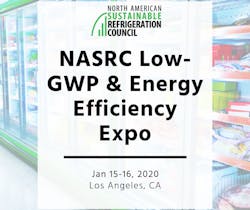NASRC Expo to Debut in California, Jan. 15-16
Irwindale, California – On January 15th and 16th, North American Sustainable Refrigeration Council (NASRC) and Southern California Edison (SCE) will co-host the first-ever Low-GWP & Energy Efficiency Expo, which will showcase the latest commercial refrigeration technologies and solutions that offer both low-GWP and energy efficiency benefits in new and existing facilities.
This event will build on a workshop NASRC co-hosted with Pacific Gas & Electric (PG&E) earlier this year, which sought to align the goals of California food retailers, California utilities, and the California Air Resources Board (CARB) by optimizing for energy efficiency with natural refrigerants.
“After our July workshop, it became clear that food retailers, service contractors, government agencies, and utilities were looking for an easy way to identify technologies that are both energy efficient and compatible with refrigerants below 150 GWP,” said Danielle Wright, executive director of the NASRC. “Our goal with this event is to provide a platform to showcase these technologies in the context of California regulations.”
In 2017, CARB proposed new regulations that will require all new systems to use refrigerants with a GWP of 150 or less starting in 2022, causing many California grocers and food retailers to explore natural refrigerant technologies and solutions.
Sources from NASRC say natural refrigerants, including hydrocarbons, carbon dioxide, and ammonia, offer a “future-proof” solution in terms of regulations, but also present a unique set of challenges. Not only do these technologies often come at an upfront cost premium compared to traditional technologies, but a shortage of trusted data has led to uncertainty around energy performance and other lifecycle costs. What’s more, because natural refrigerants are not a “drop-in” solution, existing stores require a full system replacement, making a natural refrigerant “retrofit” unfeasible in most facilities.
California utilities offer a variety of programs that can help finance the adoption of energy efficient refrigerant technologies, such as on-bill financing, emerging technologies funding, and custom incentive programs. By incorporating low-GWP refrigerant technologies into new and existing programs utilities can support CARB in reaching their emissions reductions targets and California food retailers to adopt low-GWP technologies without breaking the bank.
“Utility incentives and other funding sources that offset the upfront costs of these technologies have the power to increase volumes of adoption and drive us closer to reaching economies of scale where we see the costs of these technologies fall,” said Wright. “But for that to happen, utilities, government agencies, and supermarkets need to have a better understanding of which technologies below 150 GWP also offer energy efficiency benefits in both new and existing facilities.”
This free, two-day event seeks to provide clarity by highlighting a diversity of commercial refrigeration products that are compatible with refrigerants below 150 GWP and have proven energy efficiency benefits through a product expo, technomercials, case studies, and an emerging technologies “Shark Tank” session. Attendees will also hear updates on California refrigerant regulations, current and future offerings from California utilities, and 2022 Title 24 energy code impacts.
This event will be attended by grocery and food retailers, service contractors, equipment manufacturers & suppliers, utilities, policymakers, government agencies, and other key commercial refrigeration stakeholders.
Manufacturers interested in exhibiting should contact the NASRC at [email protected] – applications must be submitted by November 15th. For more information or to register for the expo, visit www.nasrc.org/energy-efficiency-expo

